Class 11: Maths Chapter 28 solutions. Complete Class 11 Maths Chapter 28 Notes.
Contents
RD Sharma Solutions for Class 11 Maths Chapter 28–Introduction to Three Dimensional Coordinate Geometry
RD Sharma 11th Maths Chapter 28, Class 11 Maths Chapter 28 solutions
Exercise 28.1 PAGE NO: 28.6
1. Name the octants in which the following points lie:
(i) (5, 2, 3)
(ii) (-5, 4, 3)
(iii) (4, -3, 5)
(iv) (7, 4, -3)
(v) (-5, -4, 7)
(vi) (-5, -3, -2)
(vii) (2, -5, -7)
(viii) (-7, 2, -5)
Solution:
(i) (5, 2, 3)
In this case, since x, y and z all three are positive then octant will be XOYZ
(ii) (-5, 4, 3)
In this case, since x is negative and y and z are positive then the octant will be X′OYZ
(iii) (4, -3, 5)
In this case, since y is negative and x and z are positive then the octant will be XOY′Z
(iv) (7, 4, -3)
In this case, since z is negative and x and y are positive then the octant will be XOYZ′
(v) (-5, -4, 7)
In this case, since x and y are negative and z is positive then the octant will be X′OY′Z
(vi) (-5, -3, -2)
In this case, since x, y and z all three are negative then octant will be X′OY′Z′
(vii) (2, -5, -7)
In this case, since z and y are negative and x is positive then the octant will be XOY′Z′
(viii) (-7, 2, -5)
In this case, since x and z are negative and x is positive then the octant will be X′OYZ′
2. Find the image of:
(i) (-2, 3, 4) in the yz-plane
(ii) (-5, 4, -3) in the xz-plane
(iii) (5, 2, -7) in the xy-plane
(iv) (-5, 0, 3) in the xz-plane
(v) (-4, 0, 0) in the xy-plane
Solution:
(i) (-2, 3, 4)
Since we need to find its image in yz-plane, a sign of its x-coordinate will change
So, Image of point (-2, 3, 4) is (2, 3, 4)
(ii)(-5, 4, -3)
Since we need to find its image in xz-plane, sign of its y-coordinate will change
So, Image of point (-5, 4, -3) is (-5, -4, -3)
(iii) (5, 2, -7)
Since we need to find its image in xy-plane, a sign of its z-coordinate will change
So, Image of point (5, 2, -7) is (5, 2, 7)
(iv) (-5, 0, 3)
Since we need to find its image in xz-plane, sign of its y-coordinate will change
So, Image of point (-5, 0, 3) is (-5, 0, 3)
(v) (-4, 0, 0)
Since we need to find its image in xy-plane, sign of its z-coordinate will change
So, Image of point (-4, 0, 0) is (-4, 0, 0)
3. A cube of side 5 has one vertex at the point (1, 0, 1), and the three edges from this vertex are, respectively, parallel to the negative x and y-axes and positive z-axis. Find the coordinates of the other vertices of the cube.
Solution:
Given: A cube has side 4 having one vertex at (1, 0, 1)
Side of cube = 5
We need to find the coordinates of the other vertices of the cube.
So let the Point A(1, 0, 1) and AB, AD and AE is parallel to –ve x-axis, -ve y-axis and +ve z-axis respectively.
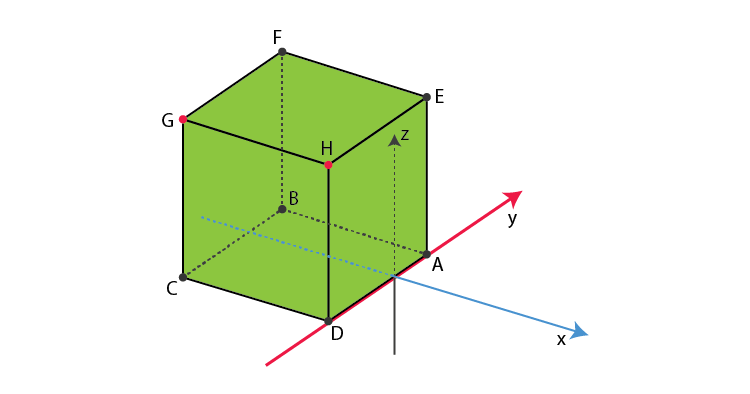
Since side of cube = 5
Point B is (-4, 0, 1)
Point D is (1, -5, 1)
Point E is (1, 0, 6)
Now, EH is parallel to –ve y-axis
Point H is (1, -5, 6)
HG is parallel to –ve x-axis
Point G is (-4, -5, 6)
Now, again GC and GF is parallel to –ve z-axis and +ve y-axis respectively
Point C is (-4, -5, 1)
Point F is (-4, 0, 6)
4. Planes are drawn parallel to the coordinates planes through the points (3, 0, -1) and (-2, 5, 4). Find the lengths of the edges of the parallelepiped so formed.
Solution:
Given:
Points are (3, 0, -1) and (-2, 5, 4)
We need to find the lengths of the edges of the parallelepiped formed.
For point (3, 0, -1)
x1 = 3, y1 = 0 and z1 = -1
For point (-2, 5, 4)
x2 = -2, y2 = 5 and z2 = 4
Plane parallel to coordinate planes of x1 and x2 is yz-plane
Plane parallel to coordinate planes of y1 and y2 is xz-plane
Plane parallel to coordinate planes of z1 and z2 is xy-plane
Distance between planes x1 = 3 and x2 = -2 is 3 – (-2) = 3 + 2 = 5
Distance between planes x1 = 0 and y2 = 5 is 5 – 0 = 5
Distance between planes z1 = -1 and z2 = 4 is 4 – (-1) = 4 + 1 = 5
∴Theedges of parallelepiped is 5, 5, 5
5. Planes are drawn through the points (5, 0, 2) and (3, -2, 5) parallel to the coordinate planes. Find the lengths of the edges of the rectangular parallelepiped so formed.
Solution:
Given:
Points are (5, 0, 2) and (3, -2, 5)
We need to find the lengths of the edges of the parallelepiped formed
For point (5, 0, 2)
x1 = 5, y1 = 0 and z1 = 2
For point (3, -2, 5)
x2 = 3, y2 = -2 and z2 = 5
Plane parallel to coordinate planes of x1 and x2 is yz-plane
Plane parallel to coordinate planes of y1 and y2 is xz-plane
Plane parallel to coordinate planes of z1 and z2 is xy-plane
Distance between planes x1 = 5 and x2 = 3 is 5 – 3 = 2
Distance between planes x1 = 0 and y2 = -2 is 0 – (-2) = 0 + 2 = 2
Distance between planes z1 = 2 and z2 = 5 is 5 – 2 = 3
∴Theedges of parallelepiped is 2, 2, 3
6. Find the distances of the point P (-4, 3, 5) from the coordinate axes.
Solution:
Given:
The point P (-4, 3, 5)
The distance of the point from x-axis is given as:
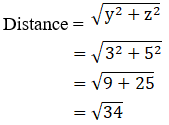
The distance of the point from y-axis is given as:
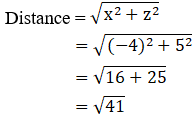
The distance of the point from z-axis is given as:
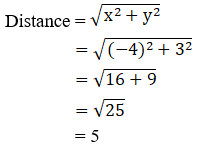
7. The coordinates of a point are (3, -2, 5). Write down the coordinates of seven points such that the absolute values of their coordinates are the same as those of the coordinates of the given point.
Solution:
Given:
Point (3, -2, 5)
The Absolute value of any point(x, y, z) is given by,
√(x2 + y2 + z2)
We need to make sure that absolute value to be the same for all points.
So let the point A(3, -2, 5)
Remaining 7 points are:
Point B(3, 2, 5) (By changing the sign of y coordinate)
Point C(-3, -2, 5) (By changing the sign of x coordinate)
Point D(3, -2, -5) (By changing the sign of z coordinate)
Point E(-3, 2, 5) (By changing the sign of x and y coordinate)
Point F(3, 2, -5) (By changing the sign of y and z coordinate)
Point G(-3, -2, -5) (By changing the sign of x and z coordinate)
Point H(-3, 2, -5) (By changing the sign of x, y and z coordinate)
ExERCISE 28.2 PAGE NO: 28.9
1. Find the distance between the following pairs of points:
(i) P(1, -1, 0) and Q (2, 1, 2)
(ii) A(3, 2, -1) and B (-1, -1, -1)
Solution:
(i) P(1, -1, 0) and Q (2, 1, 2)
Given:
The points P(1, -1, 0) and Q (2, 1, 2)
By using the formula,
The distance between any two points (a, b, c) and (m, n, o) is given by,
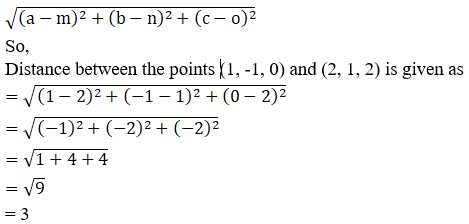
∴ The Distance between P and Q is 3 units.
(ii) A (3, 2, -1) and B (-1, -1, -1)
Given:
The points A (3, 2, -1) and B (-1, -1, -1)
By using the formula,
The distance between any two points (a, b, c) and (m, n, o) is given by,

= 5
∴ The Distance between A and B is 5 units.
2. Find the distance between the points P and Q having coordinates (-2, 3, 1) and (2, 1, 2).
Solution:
Given:
The points (-2, 3, 1) and (2, 1, 2)
By using the formula,
The distance between any two points (a, b, c) and (m, n, o) is given by,
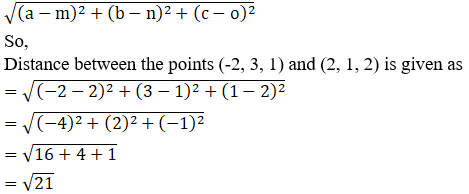
∴ The Distance between the given two points is √21 units.
3. Using distance formula prove that the following points are collinear:
(i) A(4, -3, -1), B(5, -7, 6) and C(3, 1, -8)
(ii) P(0, 7, -7), Q(1, 4, -5) and R(-1, 10, -9)
(iii) A(3, -5, 1), B(-1, 0, 8) and C(7, -10, -6)
Solution:
(i) A(4, -3, -1), B(5, -7, 6) and C(3, 1, -8)
Given:
The points A(4, -3, -1), B(5, -7, 6) and C(3, 1, -8)
Points A, B and C are collinear if AB + BC = AC or AB + AC = BC or AC + BC = AB
By using the formula,
The distance between any two points (a, b, c) and (m, n, o) is given by,

= √66

∴The points A, B and C are collinear.
(ii) P (0, 7, -7), Q (1, 4, -5) and R (-1, 10, -9)
Given:
The points P (0, 7, -7), Q (1, 4, -5) and R (-1, 10, -9)
Points P, Q and R are collinear if PQ + QR = PR or PQ + PR = QR or PR + QR = PQ
By using the formula,
Distance between any two points (a, b, c) and (m, n, o) is given by,
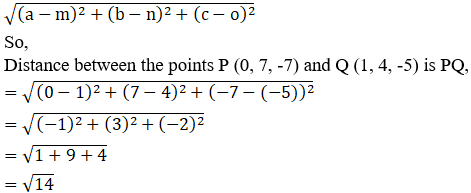
= √14
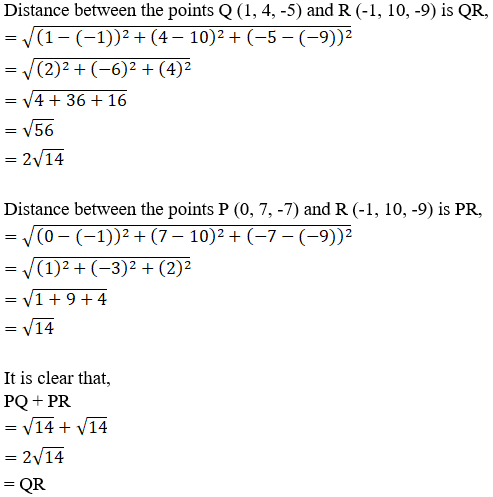
∴The points P, Q and R are collinear.
(iii) A(3, -5, 1), B(-1, 0, 8) and C(7, -10, -6)
Given:
The points A(3, -5, 1), B(-1, 0, 8) and C(7, -10, -6)
Points A, B and C are collinear if AB + BC = AC or AB + AC = BC or AC + BC = AB
By using the formula,
The distance between any two points (a, b, c) and (m, n, o) is given by,


∴The points A, B and C are collinear.
4. Determine the points in (i) xy-plane (ii) yz-plane and (iii) zx-plane which are equidistant from the points A(1, -1, 0), B(2, 1, 2) and C(3, 2, -1).
Solution:
Given:
The points A(1, -1, 0), B(2, 1, 2) and C(3, 2, -1)
(i) xy-plane
We know z = 0 in xy-plane.
So let P(x, y, 0) be any point in xy-plane
According to the question:
PA = PB = PC
PA2 = PB2 = PC2
By using the formula,
The distance between any two points (a, b, c) and (m, n, o) is given by,

We know PA2 = PB2
So, (x – 1)2+ (y + 1)2 = (x – 2)2 + (y – 1)2 + 4
x2+ 1 – 2x + y2 + 1 + 2y = x2+ 4 – 4x + y2 + 1 – 2y + 4
– 2x + 2 + 2y = 9 – 4x – 2y
– 2x + 2 + 2y – 9 + 4x + 2y = 0
2x + 4y – 7 = 0
2x = – 4y + 7……………………(1)
Since, PA2 = PC2
So, (x – 1)2+ (y + 1)2 = (x – 3)2 + (y – 2)2 + 1
x2+ 1 – 2x + y2 + 1 + 2y = x2+ 9 – 6x + y2 + 4 – 4y + 1
– 2x + 2 + 2y = 14 – 6x – 4y
– 2x + 2 + 2y – 14 + 6x + 4y = 0
4x + 6y – 12 = 0
2(2x + 3y – 6) = 0
Now substitute the value of 2x (obtained in equation (1)), we get
7 – 4y + 3y – 6 = 0
– y + 1 = 0
y = 1
By substituting the value of y back in equation (1) we get,
2x = 7 – 4y
2x = 7 – 4(1)
2x = 3
x = 3/2
∴The point P (3/2, 1, 0) in xy-plane is equidistant from A, B and C.
(ii) yz-plane
We know x = 0 in yz-plane.
Let Q(0, y, z) any point in yz-plane
According to the question:
QA = QB = QC
QA2 = QB2 = QC2
By using the formula,
The distance between any two points (a, b, c) and (m, n, o) is given by,
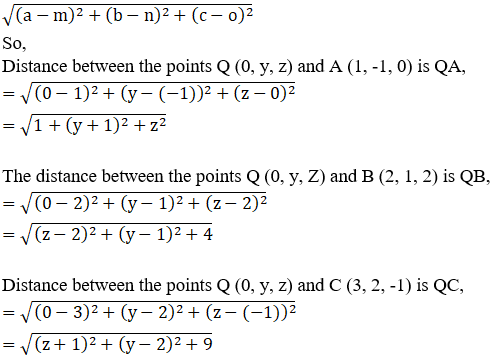
We know, QA2 = QB2
So, 1 + z2+ (y + 1)2 = (z – 2)2 + (y – 1)2 + 4
z2+ 1 + y2 + 1 + 2y = z2+ 4 – 4z + y2 + 1 – 2y + 4
2 + 2y = 9 – 4z – 2y
2 + 2y – 9 + 4z + 2y = 0
4y + 4z – 7 = 0
4z = –4y + 7
z = [–4y + 7]/4 …. (1)
Since, QA2 = QC2
So, 1 + z2+ (y + 1)2 = (z + 1)2 + (y – 2)2 + 9
2+ 1 + y2 + 1 + 2y = z2+ 1 + 2z + y2 + 4 – 4y + 9
2 + 2y = 14 + 2z – 4y
2 + 2y – 14 – 2z + 4y = 0
–2z + 6y – 12 = 0
2(–z + 3y – 6) = 0
Now, substitute the value of z [obtained from (1)] we get

12y + 4y – 7 – 24 = 0
16y – 31 = 0
y = 31/16
Substitute the value of y back in equation (1), we get

= -3/16
∴The point Q (0, 31/16, -3/16) in yz-plane is equidistant from A, B and C.
(iii) zx-plane
We know y = 0 in xz-plane.
Let R(x, 0, z) any point in xz-plane
According to the question:
RA = RB = RC
RA2 = RB2 = RC2
By using the formula,
The distance between any two points (a, b, c) and (m, n, o) is given by,
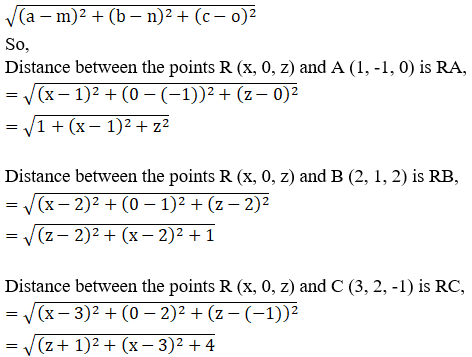
We know, RA2 = RB2
So, 1 + z2+ (x – 1)2 = (z – 2)2 + (x – 2)2 + 1
z2+ 1 + x2 + 1 – 2x = z2+ 4 – 4z + x2 + 4 – 4x + 1
2 – 2x = 9 – 4z – 4x
2 + 4z – 9 + 4x – 2x = 0
2x + 4z – 7 = 0
2x = –4z + 7……………………………(1)
Since, RA2 = RC2
So, 1 + z2+ (x – 1)2 = (z + 1)2 + (x – 3)2 + 4
z2+ 1 + x2 + 1 – 2x = z2+ 1 + 2z + x2 + 9 – 6x + 4
2 – 2x = 14 + 2z – 6x
2 – 2x – 14 – 2z + 6x = 0
–2z + 4x – 12 = 0
2(2x) = 12 + 2z
Substitute the value of 2x [obtained from equation (1)] we get,
2(–4z + 7) = 12 + 2z
–8z + 14 = 12 + 2z
14 – 12 = 8z + 2z
10z = 2
z = 2/10
= 1/5
Now, substitute the value of z back in equation (1), we get
2x = -4z + 7

∴The point R (31/10, 0, 1/5) in xz-plane is equidistant from A, B and C.
5. Determine the point on z-axis which is equidistant from the points (1, 5, 7) and (5, 1, -4)
Solution:
Given:
The points (1, 5, 7) and (5, 1, -4)
We know x = 0 and y = 0 on z-axis
Let R(0, 0, z) any point on z-axis
According to the question:
RA = RB
RA2 = RB2
By using the formula,
The distance between any two points (a, b, c) and (m, n, o) is given by,
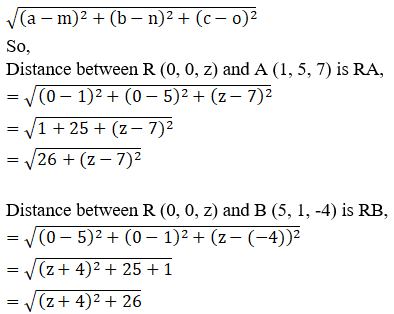
We know, RA2 = RB2
26+ (z – 7)2 = (z + 4)2 + 26
z2+ 49 – 14z + 26 = z2+ 16 + 8z + 26
49 – 14z = 16 + 8z
49 – 16 = 14z + 8z
22z = 33
z = 33/22
= 3/2
∴The point R (0, 0, 3/2) on z-axis is equidistant from (1, 5, 7) and (5, 1, -4).
6. Find the point on y-axis which is equidistant from the points (3, 1, 2) and (5, 5, 2).
Solution:
Given:
The points (3, 1, 2) and (5, 5, 2)
We know x = 0 and z = 0 on y-axis
Let R(0, y, 0) any point on the y-axis
According to the question:
RA = RB
RA2 = RB2
By using the formula,
The distance between any two points (a, b, c) and (m, n, o) is given by,

So,

We know, RA2 = RB2
13+ (y – 1)2 = (y – 5)2 + 29
y2+ 1 – 2y + 13 = y2+ 25 – 10y + 29
10y – 2y = 54 – 14
8y = 40
y = 40/8
= 5
∴The point R (0, 5, 0) on y-axis is equidistant from (3, 1, 2) and (5, 5, 2).
7. Find the points on z-axis which are at a distance√21 from the point (1, 2, 3).
Solution:
Given:
The point (1, 2, 3)
Distance = √21
We know x = 0 and y = 0 on z-axis
Let R(0, 0, z) any point on z-axis
According to question:
RA = √21
RA2 = 21
By using the formula,
The distance between any two points (a, b, c) and (m, n, o) is given by,
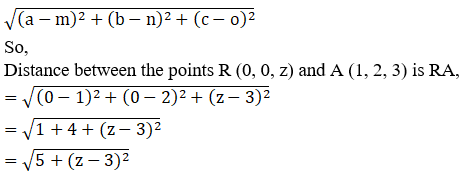

We know, RA2 = 21
5 + (z – 3)2 = 21
z2+ 9 – 6z + 5 = 21
z2 – 6z = 21 – 14
z2– 6z – 7 = 0
z2– 7z + z – 7 = 0
z(z– 7) + 1(z – 7) = 0
(z– 7) (z + 1) = 0
(z– 7) = 0 or (z + 1) = 0
z= 7 or z = -1
∴The points (0, 0, 7) and (0, 0, -1) on z-axis is equidistant from (1, 2, 3).
8. Prove that the triangle formed by joining the three points whose coordinates are (1, 2, 3), (2, 3, 1) and (3, 1, 2) is an equilateral triangle.
Solution:
Given:
The points (1, 2, 3), (2, 3, 1) and (3, 1, 2)
An equilateral triangle is a triangle whose all sides are equal.
So let us prove AB = BC = AC
By using the formula,
The distance between any two points (a, b, c) and (m, n, o) is given by,

= √6

It is clear that,
AB = BC = AC
Δ ABC is a equilateral triangle
Hence Proved.
9. Show that the points (0, 7, 10), (-1, 6, 6) and (-4, 9, 6) are the vertices of an isosceles right-angled triangle.
Solution:
Given:
The points (0, 7, 10), (-1, 6, 6) and (-4, 9, 6)
Isosceles right-angled triangle is a triangle whose two sides are equal and also satisfies Pythagoras Theorem.
By using the formula,
The distance between any two points (a, b, c) and (m, n, o) is given by,

Since, AB = BC
So, AB2 + BC2
= (3√2)2 + (3√2)2
= 18 + 18
= 36
= AC2
We know that, AB = BC and AB2 + BC2 = AC2
So, Δ ABC is an isosceles-right angled triangle
Hence Proved.
10. Show that the points A(3, 3, 3), B(0, 6, 3), C(1, 7, 7) and D(4, 4, 7) are the vertices of squares.
Solution:
Given:
The points A (3, 3, 3), B (0, 6, 3), C (1, 7, 7) and D (4, 4, 7)
We know that all sides of a square are equal.
By using the formula,
The distance between any two points (a, b, c) and (m, n, o) is given by,
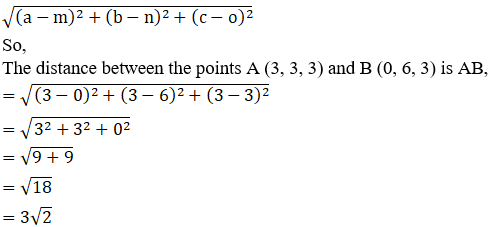
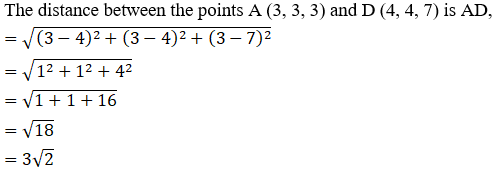
It is clear that,
AB = BC = CD = AD
Quadrilateral formed by ABCD is a square. [Since all sides are equal]
Hence Proved.
11. Prove that the point A(1, 3, 0), B(-5, 5, 2), C(-9, -1, 2) and D(-3, -3, 0) taken in order are the vertices of a parallelogram. Also, show that ABCD is not a rectangle.
Solution:
Given:
The points A (1, 3, 0), B (-5, 5, 2), C (-9, -1, 2) and D (-3, -3, 0)
We know that, opposite sides of both parallelogram and rectangle are equal.
But diagonals of a parallelogram are not equal whereas they are equal for rectangle.
By using the formula,
The distance between any two points (a, b, c) and (m, n, o) is given by,
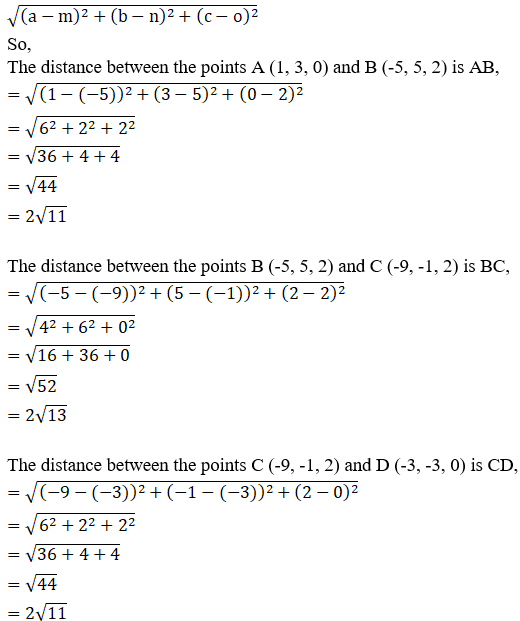


It is clear that,
AB = CD
BC = AD
Opposite sides are equal
Now, let us find the length of diagonals
By using the formula,

It is clear that,
AC ≠ BD
The diagonals are not equal, but opposite sides are equal.
So we can say that quadrilateral formed by ABCD is a parallelogram but not a rectangle.
Hence Proved.
12.Show that the points A(1, 3, 4), B(-1, 6, 10), C(-7, 4, 7) and D(-5, 1, 1) are the vertices of a rhombus.
Solution:
Given:
The points A (1, 3, 4), B (-1, 6, 10), C (-7, 4, 7) and D (-5, 1, 1)
We know that, all sides of both square and rhombus are equal.
But diagonals of a rhombus are not equal whereas they are equal for square.
By using the formula,
The distance between any two points (a, b, c) and (m, n, o) is given by,
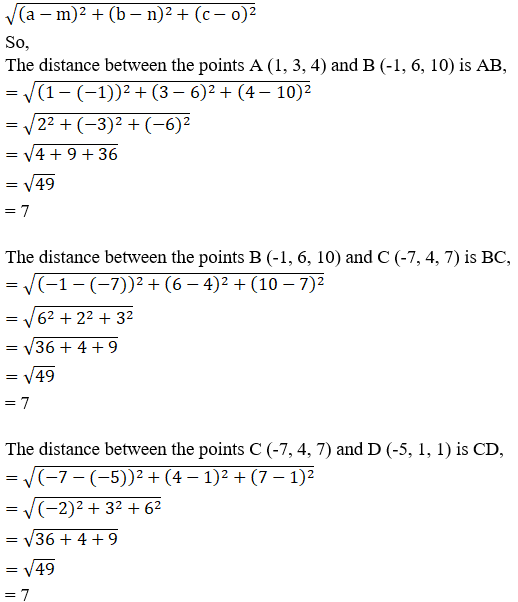

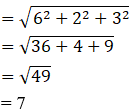
It is clear that,
AB = BC = CD = AD
So, all sides are equal
Now, let us find the length of diagonals
By using the formula,

It is clear that,
AC ≠ BD
The diagonals are not equal but all sides are equal.
So we can say that quadrilateral formed by ABCD is a rhombus but not square.
Hence Proved.
ExERCISE 28.3 PAGE NO: 28.19
1. The vertices of the triangle are A(5, 4, 6), B(1, -1, 3) and C(4, 3, 2). The internal bisector of angle A meets BC at D. Find the coordinates of D and the length AD.
Solution:
Given:
The vertices of the triangle are A (5, 4, 6), B (1, -1, 3) and C (4, 3, 2).
By using the formulas let us find the coordinates of D and the length of AD
The distance between any two points (a, b, c) and (m, n, o) is given by,

The section formula is given as


AB : AC = 5:3
BD: DC = 5:3
So, m = 5 and n = 3
B(1, -1, 3) and C(4, 3, 2)
Coordinates of D using section formula:

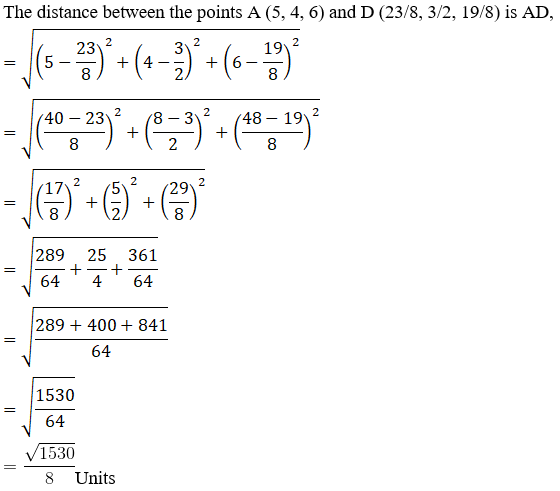

2. A point C with z-coordinate 8 lies on the line segment joining the points A(2, -3, 4) and B(8, 0, 10). Find the coordinates.
Solution:
Given:
The points A (2, -3, 4) and B (8, 0, 10)
By using the section formula,

Let Point C(x, y, 8), and C divides AB in ratio k: 1
So, m = k and n = 1
A(2, -3, 4) and B(8, 0, 10)
Coordinates of C are:

On comparing we get,[10k + 4] / [k + 1] = 8
10k + 4 = 8(k + 1)
10k + 4 = 8k + 8
10k – 8k = 8 – 4
2k = 4
k = 4/2
= 2
Here C divides AB in ratio 2:1
x = [8k + 2] / [k + 1]
= [8(2) + 2] / [2 + 1]
= [16 + 2] / [3]
= 18/3
= 6
y = -3 / [k + 1]
= -3 / [2 + 1]
= -3 / 3
= -1
∴ The Coordinates of C are (6, -1, 8).
3. Show that the three points A(2, 3, 4), B(-1, 2, -3) and C(-4, 1, -10) are collinear and find the ratio in which C divides AB.
Solution:
Given:
The points A (2, 3, 4), B (-1, 2, -3) and C (-4, 1, -10)
By using the section formula,

Let C divides AB in ratio k: 1
Three points are collinear if the value of k is the same for x, y and z coordinates.
So, m = k and n = 1
A(2, 3, 4), B(-1, 2, -3) and C(-4, 1, -10)
Coordinates of C are:

On comparing we get,[-k + 2] / [k + 1] = -4
-k + 2 = -4(k + 1)
-k + 2 = -4k – 4
4k – k = – 2 – 4
3k = -6
k = -6/3
= -2[2k + 3] / [k + 1] = 1
2k + 3 = k + 1
2k – k = 1 – 3
k = – 2[-3k + 4] / [k + 1] = -10
-3k + 4 = -10(k + 1)
-3k + 4 = -10k – 10
-3k + 10k = -10 – 4
7k = -14
k = -14/7
= -2
The value of k is the same in all three cases.
So, A, B and C are collinear [as k = -2]
∴We can say that, C divides AB externally in ratio 2:1
4. Find the ratio in which the line joining (2, 4, 5) and (3, 5, 4) is divided by the yz-plane.
Solution:
Given:
The points (2, 4, 5) and (3, 5, 4)
By using the section formula,

We know X coordinate is always 0 on yz-plane
So, let Point C(0, y, z), and let C divide AB in ratio k: 1
Then, m = k and n = 1
A(2, 4, 5) and B(3, 5, 4)
The coordinates of C are:

On comparing we get,[3k + 2] / [k + 1] = 0
3k + 2 = 0(k + 1)
3k + 2 = 0
3k = – 2
k = -2/3
∴We can say that, C divides AB externally in ratio 2: 3
5. Find the ratio in which the line segment joining the points (2, -1, 3) and (-1, 2, 1) is divided by the plane x + y + z = 5.
Solution:
Given:
The points(2, -1, 3) and (-1, 2, 1)
By using the section formula,

Let C(x, y, z) be any point on the given plane and C divides AB in ratio k: 1
Then, m = k and n = 1
A(2, -1, 3) and B(-1, 2, 1)
Coordinates of C are:

On comparing we get,[-k + 2] / [k + 1] = x[2k – 1] / [k + 1] = y[-k + 3] / [k + 1] = z
We know that x + y + z = 5

5(k + 1) = 4
5k + 5 = 4
5k = 4 – 5
5k = – 1
k = -1/5
∴We can say that, the plane divides AB externally in the ratio 1:5
6. If the points A(3, 2, -4), B(9, 8, -10) and C(5, 4, -6) are collinear, find the ratio in which C divided AB.
Solution:
Given:
The points A (3, 2, -4), B (9, 8, -10) and C (5, 4, -6)
By using the section formula,

Let C divides AB in ratio k: 1
Three points are collinear if the value of k is the same for x, y and z coordinates.
Then, m = k and n = 1
A(3, 2, -4), B(9, 8, -10) and C(5, 4, -6)
Coordinates of C are:

On comparing we get,[9k + 3] / [k + 1] = 5
9k + 3 = 5(k + 1)
9k + 3 = 5k + 5
9k – 5k = 5 – 3
4k = 2
k = 2/4
= ½[8k + 2] / [k + 1] = 4
8k + 2 = 4(k + 1)
8k + 2 = 4k + 4
8k – 4k = 4 – 2
4k = 2
k = 2/4
= ½[-10k – 4] / [k + 1] = -6
-10k – 4 = -6(k + 1)
-10k – 4 = -6k – 6
-10k + 6k = 4 – 6
-4k = -2
k = -2/-4
= ½
The value of k is the same in all three cases.
So, A, B and C are collinear [as, k = ½]
∴We can say that, C divides AB externally in ratio 1:2
7. The mid-points of the sides of a triangle ABC are given by (-2, 3, 5), (4, -1, 7) and (6, 5, 3). Find the coordinates of A, B and C.
Solution:
Given:
The mid-points of the sides of a triangle ABC is given as (-2, 3, 5), (4, -1, 7) and (6, 5, 3).
By using the section formula,

We know the mid-point divides side in the ratio of 1:1.
The coordinates of C is given by,

P(-2, 3, 5) is mid-point of A(x1, y1, z1) and B(x2, y2, z2)
Then,

Q(4, -1, 7) is mid-point of B(x2, y2, z2) and C(x3, y3, z3)
Then,

R(6, 5, 3) is mid-point of A(x1, y1, z1) and C(x3, y3, z3)
Then,

Now solving for ‘x’ terms
x1 + x2 = -4……………………(4)
x2 + x3 = 8………………………(5)
x1 + x3 = 12……………………(6)
By adding equation (4), (5), (6)
x1 + x2 + x2 + x3 + x1 + x3 = 8 + 12 – 4
2x1 + 2x2 + 2x3 = 16
2(x1 + x2 + x3) = 16
x1 + x2 + x3 = 8………………………(7)
Now, subtract equation (4), (5) and (6) from equation (7) separately:
x1 + x2 + x3 – x1 – x2 = 8 – (-4)
x3 = 12
x1 + x2 + x3 – x2 – x3 = 8 – 8
x1 = 0
x1 + x2 + x3 – x1 – x3 = 8 – 12
x2 = -4
Now solving for ‘y’ terms
y1 + y2 = 6……………………(8)
y2 + y3 = -2……………………(9)
y1 + y3 = 10……………………(10)
By adding equation (8), (9) and (10) we get,
y1 + y2 + y2 + y3 + y1 + y3 = 10 + 6 – 2
2y1 + 2y2 + 2y3 = 14
2(y1 + y2 + y3) = 14
y1 + y2 + y3 = 7………………………(11)
Now, subtract equation (8), (9) and (10) from equation (11) separately:
y1 + y2 + y3 – y1 – y2 = 7 – 6
y3 = 1
y1 + y2 + y3 – y2 – y3 = 7 – (-2)
y1 = 9
y1 + y2 + y3 – y1 – y3 = 7 – 10
y2 = -3
Now solving for ‘z’ terms
z1 + z2 = 10……………………(12)
z2 + z3 = 14……………………(13)
z1 + z3 = 6……………………(14)
By adding equation (12), (13) and (14) we get,
z1 + z2 + z2 + z3 + z1 + z3 = 6 + 14 + 10
2z1 + 2z2 + 2z3 = 30
2(z1 + z2 + z3) = 30
z1 + z2 + z3 = 15………………………(15)
Now, subtract equation (8), (9) and (10) from equation (11) separately:
z1 + z2 + z3 – z1 – z2 = 15 – 10
z3 = 5
z1 + z2 + z3 – z2 – z3 = 15 – 14
z1 = 1
z1 + z2 + z3 – z1 – z3 = 15 – 6
z2 = 9
∴Thevertices of sides of a triangle ABC are A(0, 9, 1) B(-4,-3, 9) and C(12, 1, 5).
8. A(1, 2, 3), B(0, 4, 1), C(-1, -1, -3) are the vertices of a triangle ABC. Find the point in which the bisector of the angle ∠BAC meets BC.
Solution:
Given:
The vertices of a triangle are A (1, 2, 3), B (0, 4, 1), C (-1, -1, -3)
By using the distance formula,


So, AB/AC = 3/7
AB: AC = 3:7
BD: DC = 3:7
Then, m = 3 and n = 7
B(0, 4, 1) and C(-1, -1, -3)
Coordinates of D by using section formula is given as
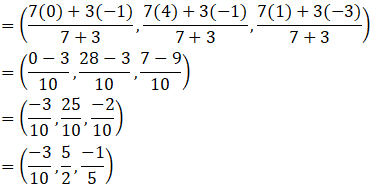
∴The coordinates of D are (-3/10, 5/2, -1/5).
RD Sharma Solutions for Class 11 Maths Chapter 28: Download PDF
RD Sharma Solutions for Class 11 Maths Chapter 28–Introduction to Three Dimensional Coordinate Geometry
Chapterwise RD Sharma Solutions for Class 11 Maths :
- Chapter 1–Sets
- Chapter 2–Relations
- Chapter 3–Functions
- Chapter 4–Measurement of Angles
- Chapter 5–Trigonometric Functions
- Chapter 6–Graphs of Trigonometric Functions
- Chapter 7–Values of Trigonometric Functions at Sum or Difference of Angles
- Chapter 8–Transformation Formulae
- Chapter 9–Values of Trigonometric Functions at Multiples and Submultiples of an Angle
- Chapter 10–Sine and Cosine Formulae and their Applications
- Chapter 11–Trigonometric Equations
- Chapter 12–Mathematical Induction
- Chapter 13–Complex Numbers
- Chapter 14–Quadratic Equations
- Chapter 15–Linear Inequations
- Chapter 16–Permutations
- Chapter 17–Combinations
- Chapter 18–Binomial Theorem
- Chapter 19–Arithmetic Progressions
- Chapter 20–Geometric Progressions
- Chapter 21–Some Special Series
- Chapter 22–Brief review of Cartesian System of Rectangular Coordinates
- Chapter 23–The Straight Lines
- Chapter 24–The Circle
- Chapter 25–Parabola
- Chapter 26–Ellipse
- Chapter 27–Hyperbola
- Chapter 28–Introduction to Three Dimensional Coordinate Geometry
- Chapter 29–Limits
- Chapter 30–Derivatives
- Chapter 31–Mathematical Reasoning
- Chapter 32–Statistics
- Chapter 33–Probability
About RD Sharma
RD Sharma isn’t the kind of author you’d bump into at lit fests. But his bestselling books have helped many CBSE students lose their dread of maths. Sunday Times profiles the tutor turned internet star
He dreams of algorithms that would give most people nightmares. And, spends every waking hour thinking of ways to explain concepts like ‘series solution of linear differential equations’. Meet Dr Ravi Dutt Sharma — mathematics teacher and author of 25 reference books — whose name evokes as much awe as the subject he teaches. And though students have used his thick tomes for the last 31 years to ace the dreaded maths exam, it’s only recently that a spoof video turned the tutor into a YouTube star.
R D Sharma had a good laugh but said he shared little with his on-screen persona except for the love for maths. “I like to spend all my time thinking and writing about maths problems. I find it relaxing,” he says. When he is not writing books explaining mathematical concepts for classes 6 to 12 and engineering students, Sharma is busy dispensing his duty as vice-principal and head of department of science and humanities at Delhi government’s Guru Nanak Dev Institute of Technology.
